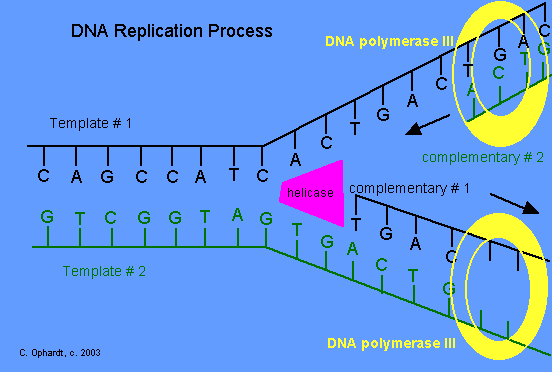CENTRAL
DOGMA
The
Central Dogma of genetics is: DNA is transcribed to RNA which is translated to protein. Protein is never back-translated to RNA or DNA; and
except... click here to read more

|
Prior to cell division, the DNA material in the original cell must be
duplicated so that after cell division, each new cell contains the full amount of DNA
material. The process of DNA duplication is usually called replication.
The replication is termed semiconservative since each new cell contains
one strand of original DNA and one newly synthesized strand of DNA. The original
polynucleotide strand of DNA serves as a template to guide the synthesis of the new
complementary polynucleotide of DNA.
The DNA single strand template serves to guide the synthesis of a
complementary strand of DNA. DNA polymerase III is an example of this process.

It is so important that the cells duplicate the DNA genetic
material exactly, that the sequence of newly synthesized nucleotides is checked by two
different polymerase enzymes - DNA polymerase II. This enzyme can check for and actually
correct any mistake of mismatched base pairs in the sequence. The mismatched nucleotides
are hydrolyzed and cut out and new correct ones are inserted.
|
DNA
REPLICATION
Prior to cell division, the DNA material in the
original cell must be duplicated so that after cell division, each new cell contains the
full amount of DNA material. The process of DNA duplication is... click here to read more
 |
TRANSCRIPTION
Transcription is the process through which a DNA
sequence is enzymatically copied by an RNA polymerase to produce a... click here to read more
 |
TRANSLATION
Eventually the mature mRNA finds its way to a ribosome, where it is
translated into a protein, another biological polymer. In prokaryotic cells, which have no
nuclear compartment, the process... click
here to read more
 |



